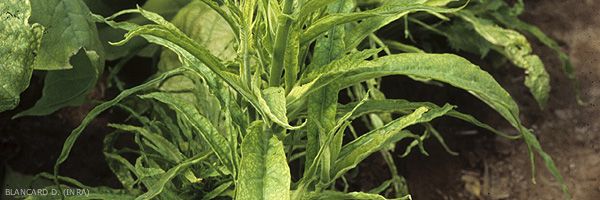
Polyphylla (or Frenching)
Faced with polyphylla (or "Frenching"), tobacco farmers observe both in nursery and in the field, rather special symptoms affecting mainly the leaves. First, a fairly marked yellowing of interveinal tissues. On the contrary, the veins remain very green, contrasting with the rest of the lamina. Then the growth of new leaves is particularly affected, and so is their shape. There is no radial growth of leaves, and ultimately they are very slender (figure 1), with the tip curled down and wavy edges (figure 2). Many developing axillary buds give rise to a rosette of numerous, small, narrow and light green leaves (hence the name polyphylla) thus giving the plant a rather characteristic witches broom appearance (figure 3).
The origin of this non-parasitic disease is unusual. It could be produced by the effects of a non-pathogenic bacteria commonly found in soil: Bacillus cereus Frankland & Frankland. It secretes a toxin and possibly other products that are diffused near the roots and absorbed by tobacco. The nitrogen and protein metabolism of plants is disturbed, increase of the free isoleucine content of and other amino acids is frequently observed. It should be noted that similar symptoms were observed in the following situations: after toxicities to thallium, manganese, lead ... or on the plants subjected to metabolites of Aspergillus wentii Whermer and Macrophomina phaseolina. Note that similar symptoms have been reported in tomato, another Solanaceae.
This disease is more frequently observed on particularly wet, poorly ventilated and rather warm soils, of neutral to alkaline pH and which sometimes are inadequately fertilised, lacking available nitrogen.
It is not possible to eradicate this physiological disease. In affected nurseries, the slightly diseased plants could be used. Their transplantation to another soil does not seem disturbed and their future development neither. Soil disinfection usually results in control of this problem in nursery.
In the field there is not any truly effective remedy during cultivation. For the next crop, one can always try to drain the plot in order to avoid excessive intake of soil alkalising elements and to ensure a balanced fertilisation.





